11 Advanced Visualizations for Data Analysis and Machine Learning
Visualization is a powerful tool for communicating complex data patterns and relationships in an intuitive and understandable way. They play a vital role in data analysis, providing insights that are often difficult to discern from raw data or traditional numerical representations.
Visualization is essential for understanding complex data patterns and relationships, and we’ll introduce 11 of the most important and must-know charts that help reveal information in your data, making Complex data is more understandable and meaningful.

1. KS Plot

KS Plot is used Evaluate distribution differences. The core idea is to measure the maximum distance between the cumulative distribution functions (CDF) of two distributions. The smaller the maximum distance, the more likely they belong to the same distribution. So it is mainly interpreted as a "statistical test" to determine the difference in distributions, rather than a "plot".
2. SHAP Plot
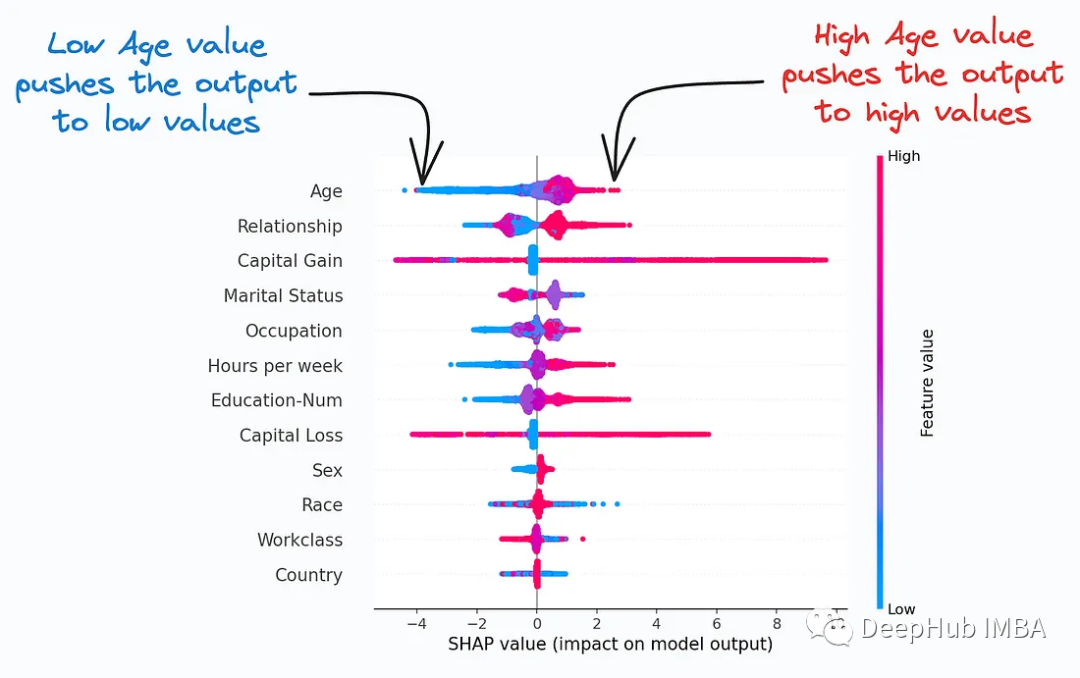
##SHAP Plot considers the interactions/dependencies between features To summarize the importance of features to model predictions. Useful when determining how different values (low or high) of a feature affect the overall output.
3. ROC Curve
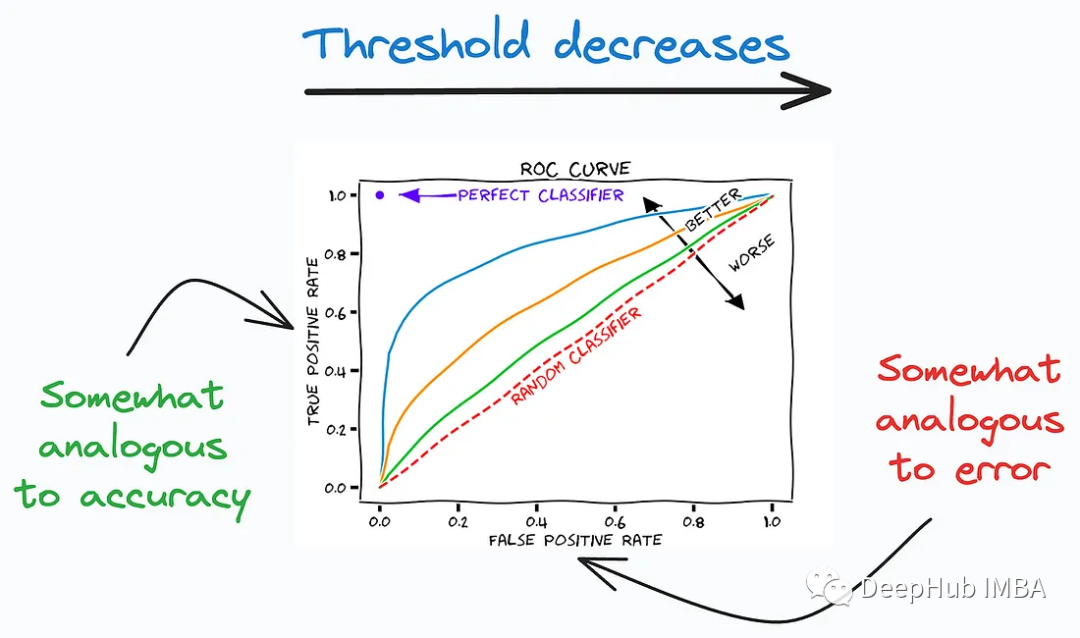
The ROC curve is a commonly used tool, particularly useful for evaluating the performance of medical diagnostic tests, machine learning classifiers, risk models, and more. By analyzing ROC curves and calculating AUC, you can better understand the performance of your classifier, select appropriate thresholds, and compare performance between different models.
4. Precision-Recall Curve
 ##Precision-Recall Curve It is another important tool for evaluating the performance of classification models, especially for problems with imbalanced class distribution, where the number of positive and negative class samples differs greatly. This curve focuses on the model’s prediction accuracy in the positive category and its ability to find all true positive examples. It describes the trade-off between precision and recall between different classification thresholds.
##Precision-Recall Curve It is another important tool for evaluating the performance of classification models, especially for problems with imbalanced class distribution, where the number of positive and negative class samples differs greatly. This curve focuses on the model’s prediction accuracy in the positive category and its ability to find all true positive examples. It describes the trade-off between precision and recall between different classification thresholds.
5. QQ Plot
##QQ Plot (Quantile-Quantile Plot, quantile-point Quantile plot) is a data visualization tool used to compare whether the quantile distributions of two data sets are similar. It is often used to check whether a data set conforms to a specific theoretical distribution, such as the normal distribution. 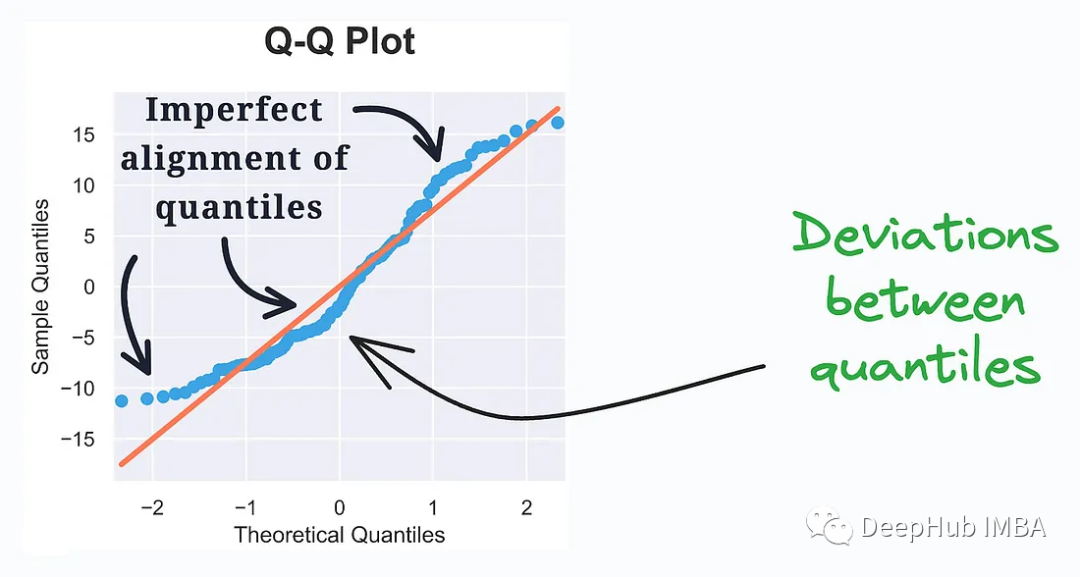
It evaluates the distribution similarity between observed data and the theoretical distribution. Quantiles of the two distributions are plotted. Deviation from a straight line represents a departure from the assumed distribution.
QQ Plot is an intuitive tool that can be used to examine the distribution of data, especially in statistical modeling and data analysis. By observing the position of the points on the QQ Plot, you can understand whether the data conforms to a certain theoretical distribution, or whether there are outliers or deviations.
6. Cumulative Explained Variance Plot
##Cumulative Explained Variance Plot (cumulative explained variance plot) is Charts commonly used in dimensionality reduction techniques such as principal component analysis (PCA) are used to help interpret the variance information contained in the data and select appropriate dimensions to represent the data.
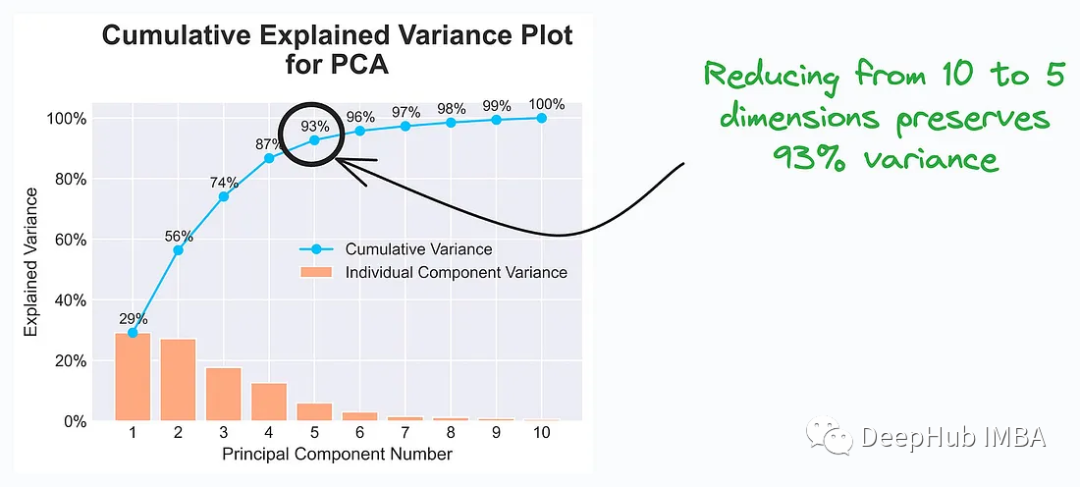
Data scientists and analysts will choose the appropriate number of principal components based on the information in the Cumulative Explained Variance Plot so that the characteristics of the data can still be effectively represented after dimensionality reduction. This helps reduce data dimensions, improve model training efficiency, and retain enough information to support successful task completion.
7, Elbow Curve
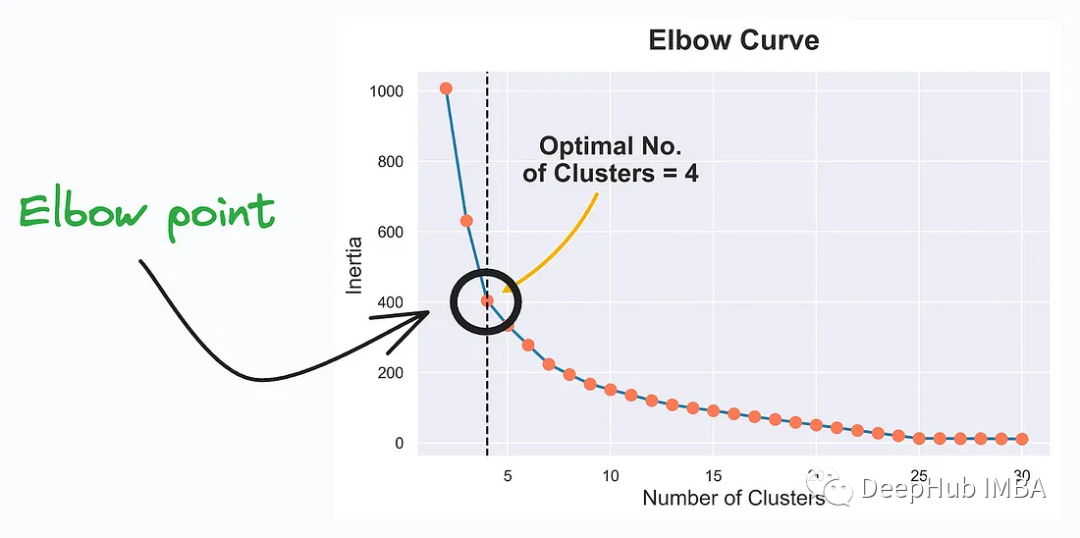
Elbow Curve (elbow curve) is a method used to help determine K-Means clustering Visualization tool for the optimal number of clusters (number of clusters) in . K-Means is a commonly used unsupervised learning algorithm used to classify data points into different clusters or groups. Elbow Curve helps find the right number of clusters to best represent the structure of your data.
Elbow Curve is a commonly used tool to help select the optimal number of clusters in K-Means clustering. The point at the elbow represents the ideal number of clusters. This better captures the underlying structure and patterns of the data.
8. Silhouette Curve
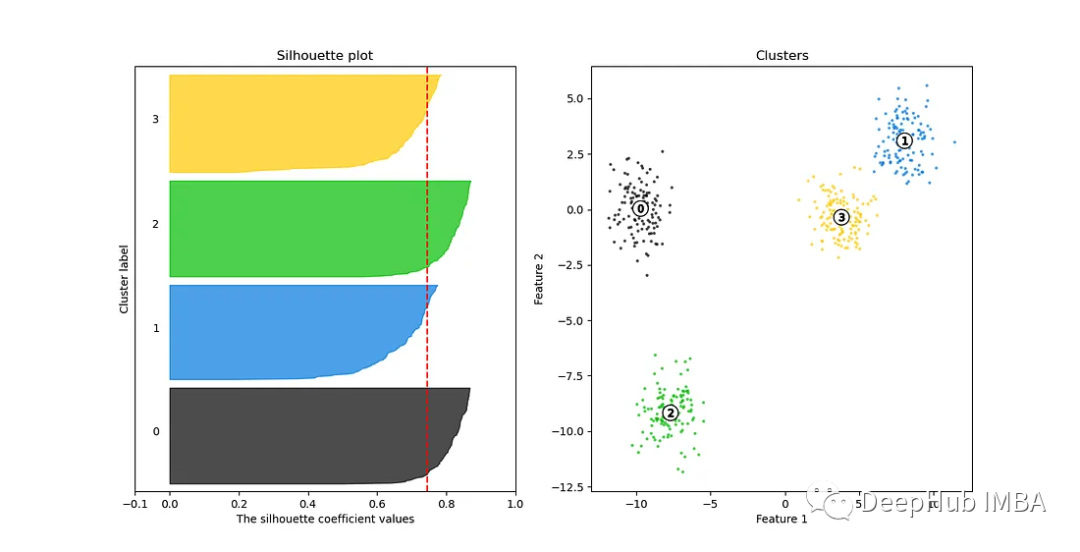
##Silhouette Curve (contour coefficient curve) is a kind of A visualization tool for clustering quality, often used to help choose the optimal number of clusters. Silhouette coefficient is a measure of the similarity of data points within clusters and the separation of data points between clusters in clustering.
Silhouette Curve is a powerful tool used to help select the optimal number of clusters to ensure that the clustering model can effectively capture the intrinsic structure and patterns of the data. Elbow curves are often ineffective when there are many clusters. Silhouette Curve is a better choice.
9、Gini-Impurity and Entropy
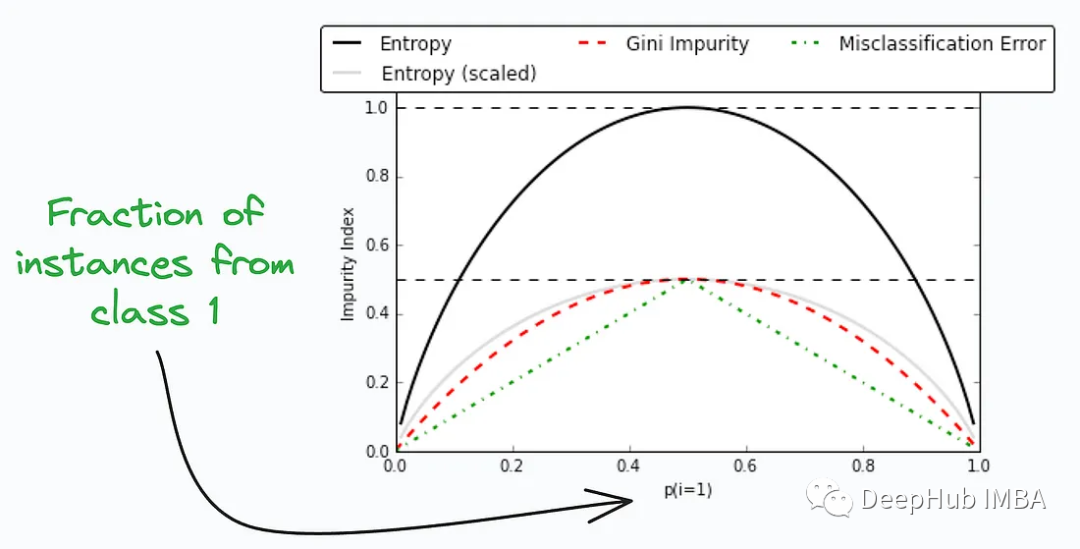
Gini Impurity (Gini Impurity) and Entropy ( Entropy) are two metrics commonly used in machine learning algorithms such as decision trees and random forests to assess the impurity of data and select the best splitting properties. They are both used to measure the amount of clutter in a data set to help decision trees choose how to divide the data.
They are used to measure the impurity or disorder of nodes or splits in a decision tree. The figure above compares Gini impurity and entropy at different splits, which can provide insights into the trade-offs between these measures.
Both are valid indicators for node splitting selection in machine learning algorithms such as decision trees, but which one to choose depends on the specific problem and data characteristics.
10. Bias-Variance Tradeoff
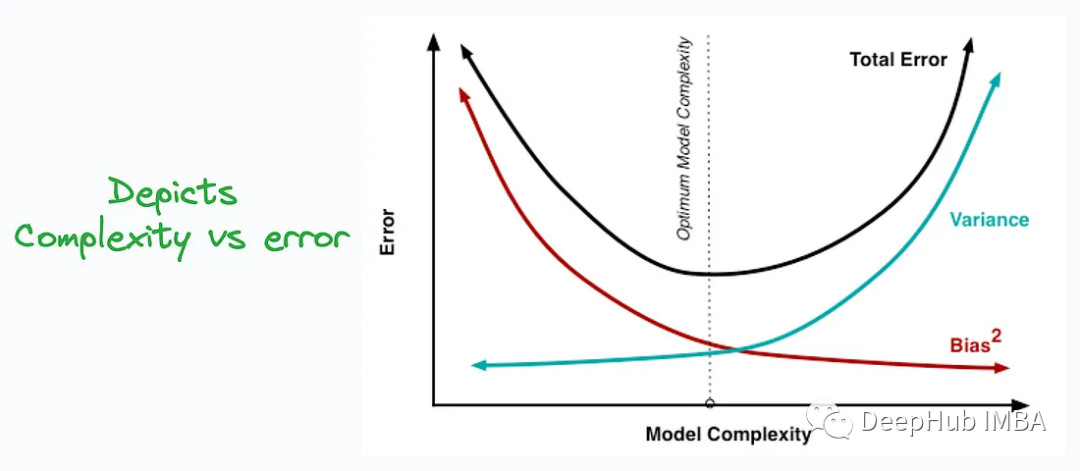
There is a trade-off between bias and variance. When training a machine learning model, increasing model complexity typically decreases bias but increases variance, while decreasing model complexity decreases variance but increases bias. Therefore, there is a trade-off point where the model is both capable of capturing patterns in the data (reducing bias) and showing stable predictions across different data (reducing variance).
Understanding the bias-variance trade-off helps machine learning practitioners better build and tune models to achieve better performance and generalization capabilities. It highlights the relationship between model complexity and data set size, and how to avoid underfitting and overfitting.
11. Partial Dependency Plots:
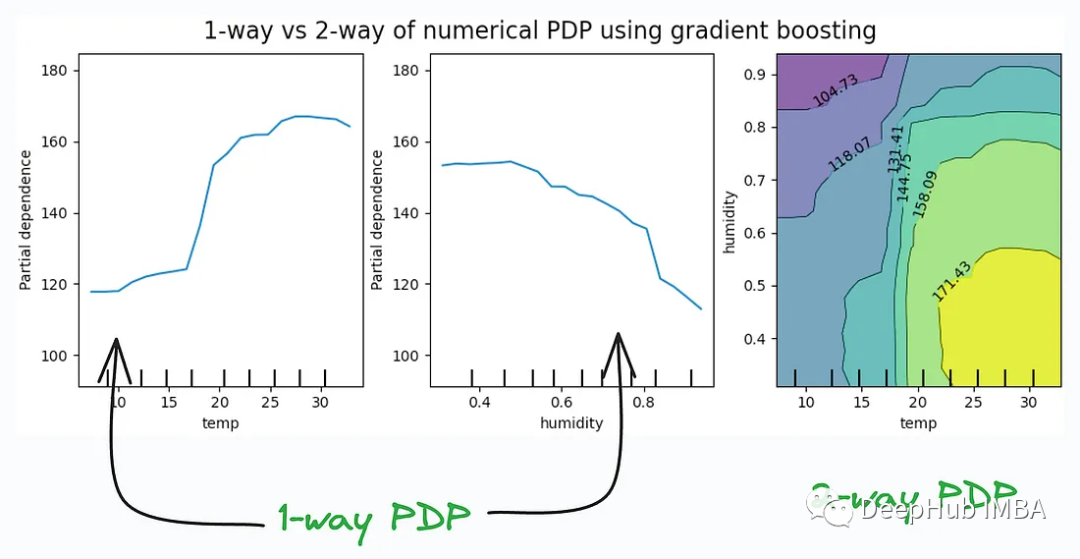
Partial Dependency Plots are often used with interpretive tools and techniques, such as SHAP values, LIME, etc., to help explain the predictions of black-box machine learning models. They provide a visualization that makes it easier for data scientists and analysts to understand the relationships between a model's decisions and features.
Summary
These diagrams touch on commonly used visualization tools and concepts in the field of data analysis and machine learning that help Evaluate and interpret model performance, understand data distribution, select optimal parameters and model complexity, and gain insight into the impact of features on predictions.
The above is the detailed content of 11 Advanced Visualizations for Data Analysis and Machine Learning. For more information, please follow other related articles on the PHP Chinese website!

Hot AI Tools

Undresser.AI Undress
AI-powered app for creating realistic nude photos

AI Clothes Remover
Online AI tool for removing clothes from photos.

Undress AI Tool
Undress images for free

Clothoff.io
AI clothes remover

Video Face Swap
Swap faces in any video effortlessly with our completely free AI face swap tool!

Hot Article

Hot Tools

Notepad++7.3.1
Easy-to-use and free code editor

SublimeText3 Chinese version
Chinese version, very easy to use

Zend Studio 13.0.1
Powerful PHP integrated development environment

Dreamweaver CS6
Visual web development tools

SublimeText3 Mac version
God-level code editing software (SublimeText3)

Hot Topics
 This article will take you to understand SHAP: model explanation for machine learning
Jun 01, 2024 am 10:58 AM
This article will take you to understand SHAP: model explanation for machine learning
Jun 01, 2024 am 10:58 AM
In the fields of machine learning and data science, model interpretability has always been a focus of researchers and practitioners. With the widespread application of complex models such as deep learning and ensemble methods, understanding the model's decision-making process has become particularly important. Explainable AI|XAI helps build trust and confidence in machine learning models by increasing the transparency of the model. Improving model transparency can be achieved through methods such as the widespread use of multiple complex models, as well as the decision-making processes used to explain the models. These methods include feature importance analysis, model prediction interval estimation, local interpretability algorithms, etc. Feature importance analysis can explain the decision-making process of a model by evaluating the degree of influence of the model on the input features. Model prediction interval estimate
 Identify overfitting and underfitting through learning curves
Apr 29, 2024 pm 06:50 PM
Identify overfitting and underfitting through learning curves
Apr 29, 2024 pm 06:50 PM
This article will introduce how to effectively identify overfitting and underfitting in machine learning models through learning curves. Underfitting and overfitting 1. Overfitting If a model is overtrained on the data so that it learns noise from it, then the model is said to be overfitting. An overfitted model learns every example so perfectly that it will misclassify an unseen/new example. For an overfitted model, we will get a perfect/near-perfect training set score and a terrible validation set/test score. Slightly modified: "Cause of overfitting: Use a complex model to solve a simple problem and extract noise from the data. Because a small data set as a training set may not represent the correct representation of all data." 2. Underfitting Heru
 Transparent! An in-depth analysis of the principles of major machine learning models!
Apr 12, 2024 pm 05:55 PM
Transparent! An in-depth analysis of the principles of major machine learning models!
Apr 12, 2024 pm 05:55 PM
In layman’s terms, a machine learning model is a mathematical function that maps input data to a predicted output. More specifically, a machine learning model is a mathematical function that adjusts model parameters by learning from training data to minimize the error between the predicted output and the true label. There are many models in machine learning, such as logistic regression models, decision tree models, support vector machine models, etc. Each model has its applicable data types and problem types. At the same time, there are many commonalities between different models, or there is a hidden path for model evolution. Taking the connectionist perceptron as an example, by increasing the number of hidden layers of the perceptron, we can transform it into a deep neural network. If a kernel function is added to the perceptron, it can be converted into an SVM. this one
 The evolution of artificial intelligence in space exploration and human settlement engineering
Apr 29, 2024 pm 03:25 PM
The evolution of artificial intelligence in space exploration and human settlement engineering
Apr 29, 2024 pm 03:25 PM
In the 1950s, artificial intelligence (AI) was born. That's when researchers discovered that machines could perform human-like tasks, such as thinking. Later, in the 1960s, the U.S. Department of Defense funded artificial intelligence and established laboratories for further development. Researchers are finding applications for artificial intelligence in many areas, such as space exploration and survival in extreme environments. Space exploration is the study of the universe, which covers the entire universe beyond the earth. Space is classified as an extreme environment because its conditions are different from those on Earth. To survive in space, many factors must be considered and precautions must be taken. Scientists and researchers believe that exploring space and understanding the current state of everything can help understand how the universe works and prepare for potential environmental crises
 Implementing Machine Learning Algorithms in C++: Common Challenges and Solutions
Jun 03, 2024 pm 01:25 PM
Implementing Machine Learning Algorithms in C++: Common Challenges and Solutions
Jun 03, 2024 pm 01:25 PM
Common challenges faced by machine learning algorithms in C++ include memory management, multi-threading, performance optimization, and maintainability. Solutions include using smart pointers, modern threading libraries, SIMD instructions and third-party libraries, as well as following coding style guidelines and using automation tools. Practical cases show how to use the Eigen library to implement linear regression algorithms, effectively manage memory and use high-performance matrix operations.
 Five schools of machine learning you don't know about
Jun 05, 2024 pm 08:51 PM
Five schools of machine learning you don't know about
Jun 05, 2024 pm 08:51 PM
Machine learning is an important branch of artificial intelligence that gives computers the ability to learn from data and improve their capabilities without being explicitly programmed. Machine learning has a wide range of applications in various fields, from image recognition and natural language processing to recommendation systems and fraud detection, and it is changing the way we live. There are many different methods and theories in the field of machine learning, among which the five most influential methods are called the "Five Schools of Machine Learning". The five major schools are the symbolic school, the connectionist school, the evolutionary school, the Bayesian school and the analogy school. 1. Symbolism, also known as symbolism, emphasizes the use of symbols for logical reasoning and expression of knowledge. This school of thought believes that learning is a process of reverse deduction, through existing
 Is Flash Attention stable? Meta and Harvard found that their model weight deviations fluctuated by orders of magnitude
May 30, 2024 pm 01:24 PM
Is Flash Attention stable? Meta and Harvard found that their model weight deviations fluctuated by orders of magnitude
May 30, 2024 pm 01:24 PM
MetaFAIR teamed up with Harvard to provide a new research framework for optimizing the data bias generated when large-scale machine learning is performed. It is known that the training of large language models often takes months and uses hundreds or even thousands of GPUs. Taking the LLaMA270B model as an example, its training requires a total of 1,720,320 GPU hours. Training large models presents unique systemic challenges due to the scale and complexity of these workloads. Recently, many institutions have reported instability in the training process when training SOTA generative AI models. They usually appear in the form of loss spikes. For example, Google's PaLM model experienced up to 20 loss spikes during the training process. Numerical bias is the root cause of this training inaccuracy,
 Explainable AI: Explaining complex AI/ML models
Jun 03, 2024 pm 10:08 PM
Explainable AI: Explaining complex AI/ML models
Jun 03, 2024 pm 10:08 PM
Translator | Reviewed by Li Rui | Chonglou Artificial intelligence (AI) and machine learning (ML) models are becoming increasingly complex today, and the output produced by these models is a black box – unable to be explained to stakeholders. Explainable AI (XAI) aims to solve this problem by enabling stakeholders to understand how these models work, ensuring they understand how these models actually make decisions, and ensuring transparency in AI systems, Trust and accountability to address this issue. This article explores various explainable artificial intelligence (XAI) techniques to illustrate their underlying principles. Several reasons why explainable AI is crucial Trust and transparency: For AI systems to be widely accepted and trusted, users need to understand how decisions are made






